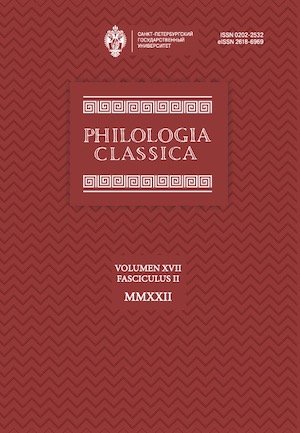A Rudimentary Motif in Greek Epic (Pylos Combat Agate and the Iliad 3. 369–376)
DOI:
https://doi.org/10.21638/spbu20.2022.201Abstract
In 2015, Jack Davis and Sharon Stocker, while excavating the so-called “Tomb of a warrior with a griffin”, discovered an agate seal with an extraordinarily detailed depiction of a combat scene. It shows a warrior armed with a sword only, bending over his adversary’s shield, grabbing him by the crest of his helmet and using it as leverage to render him absolutely powerless. The article studies the image on the Pylos combat agate as a reflection of an early epic narrative. It is shown that the account of the combat between Menelaus and Paris in the Iliad (3. 369–376) is an elaboration on a traditional epic narrative that was preserved in the text of the Iliad as a rudimentary motif (following Th. Zelinsky’s terminology). The comparison of this narrative with the Pylos combat agate allows us to comment the Homeric episode in a new way, insofar as it preserves the description of the type of helmet that was in use in the 16th–15th centuries BCE. This helmet would have permitted the adversary to turn the helmeted warrior’s head in the way that is depicted on the Pylos combat agate. It is noteworthy that the Homeric account begins with “were it not for…”, negating the version of events that was the basis of the earlier epic narrative. As a result, we are able to reconstruct several fragments of the heroic epos going back to early Mycenaean times, unsurprisingly connected (as already surmised by Ruijgh) with Peloponnesus of the 17th–15th centuries BCE.
Keywords:
Greek epic, Homer, Iliad, rudimentary motif, Pylos Combat Agate, combat of Menelaus and Paris (Il. 3. 369–376)
Downloads
References
Fenik B. Typical Battle Scenes in the Iliad. Studies in the Narrative Techniques of Homeric Battle Description. Wiesbaden, Steiner, 1968.
Ruiperez M. S., Vara J. Le mycénien et les traces d’occlusives finales dans le texte homérique. Minos 1972, 13 (2), 192–196.
Downloads
Published
How to Cite
Issue
Section
License
Articles of "Philologia Classica" are open access distributed under the terms of the License Agreement with Saint Petersburg State University, which permits to the authors unrestricted distribution and self-archiving free of charge.






